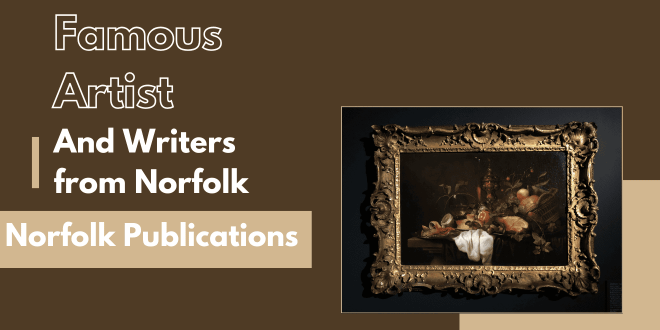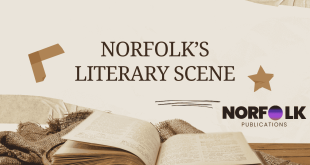Norfolk, a county in the East of England, is known for its picturesque landscapes, historical significance, and vibrant cultural scene. Over the centuries, it has produced some of the most influential artists and writers in British history.
From landscape painters who captured the serene beauty of the Norfolk countryside to writers whose works have inspired generations, Norfolk has played a key role in shaping the nation’s cultural heritage.
Famous Artists and Writers from Norfolk

In this article, we will explore some of the most famous artists and writers from Norfolk. Their contributions to literature and the visual arts have left a lasting legacy, not just in Norfolk but across the world.
Whether through their vivid depictions of rural life or their pioneering literary works, these figures have helped define Norfolk’s place on the cultural map.
1. John Crome: Founder of the Norwich School of Artists
Early Life and Artistic Beginnings
Born in Norwich in 1768, John Crome is perhaps the most famous artist to emerge from Norfolk. Crome was the founder of the Norwich School of Artists, the first provincial art movement in Britain. Known for his landscapes that celebrated the beauty of the Norfolk countryside, Crome’s work is often compared to that of the Dutch Masters, particularly in his use of light and natural settings.
Growing up in a modest family, Crome initially worked as a coach and sign painter before his talent for drawing and painting was discovered. He later apprenticed with Francis Whisler, a local artist and printer. Crome’s deep connection to the land and nature became the foundation of his artistic career, with his works depicting the idyllic and serene landscapes of Norfolk.
Notable Works
Crome’s best-known works include “Mousehold Heath” and “The Poringland Oak”, both of which reflect his fascination with the natural world. These paintings are characterized by their attention to detail, capturing the vast skies and gentle landscapes of rural Norfolk. His work often evokes a sense of calm and timelessness, which has made him a beloved figure in British art history.
Legacy
As the founder of the Norwich School, Crome’s influence extended beyond his own works. The school became a hub for local artists, promoting a style of painting that focused on the beauty of the Norfolk countryside. Crome’s vision of art as a reflection of the local environment inspired future generations of artists, and his work continues to be celebrated in galleries such as the Norwich Castle Museum and Art Gallery.
2. Anna Sewell: The Author of Black Beauty
Early Life
Anna Sewell, born in 1820 in Great Yarmouth, is one of Norfolk’s most famous literary figures. Although she wrote only one book, that book, Black Beauty, became one of the best-selling novels of all time and revolutionized the way animals, particularly horses, were treated in society. Sewell was largely confined to her home due to a lifelong illness, and she turned to writing as a means of expressing her thoughts and feelings.
Black Beauty and Its Impact
Black Beauty was first published in 1877, and it was an immediate success. The novel is told from the perspective of a horse, Black Beauty, and it chronicles his life and the various owners he serves. Through this narrative, Sewell highlights the cruelty and mistreatment that animals, particularly horses, endured during the 19th century. The book is credited with raising awareness about animal welfare and leading to improvements in the treatment of horses.
Sewell’s novel had a profound impact not only in the UK but also internationally, as it was translated into multiple languages and became a staple of children’s literature. The book’s enduring popularity is a testament to Sewell’s skill as a writer and her deep compassion for animals.
Legacy
Although Anna Sewell did not live to see the full success of Black Beauty, her legacy lives on through the millions of readers who have been touched by her work. The novel has been adapted into numerous films and television series, and Sewell’s influence can still be seen in the ongoing efforts to promote animal rights and welfare.
3. Sir Alfred Munnings: A Master of Equestrian Art
Early Life and Career
Born in 1878 in Mendham, Norfolk, Sir Alfred Munnings is widely regarded as one of the greatest equestrian painters in British history. His love for horses and rural life is evident in his paintings, which often depict horse racing, hunting scenes, and the countryside. Munnings began his career as an apprentice at a local printing firm, where he honed his skills as an illustrator. He later studied at the Norwich School of Art before moving to London to further his career.
Artistic Achievements
Munnings’ work is known for its vibrant colors, dynamic compositions, and his ability to capture the energy and grace of horses. Some of his most famous works include “The Start of the Prix de Paris”, “Morning Ride, Newmarket Heath”, and “The Red Prince Mare”. His portrayal of horses in motion is particularly celebrated, and his works have become iconic representations of British equestrian culture.
In 1944, Munnings became the president of the Royal Academy of Arts, where he advocated for traditional painting techniques in an era increasingly dominated by modernism.
Legacy
Munnings’ work remains highly regarded, and his paintings are sought after by collectors worldwide. The Munnings Art Museum, located in his former home in Dedham, Essex, showcases his extensive body of work and provides insight into his life and artistic process. His ability to capture the essence of rural and equestrian life has left a lasting mark on British art, and his works continue to inspire admiration and appreciation.
4. Sir Thomas Browne: A Literary and Scientific Pioneer
Early Life and Education
Born in London in 1605, Sir Thomas Browne spent much of his life in Norwich, where he became a prominent physician, writer, and philosopher. Browne’s writings cover a wide range of topics, including religion, science, and medicine, reflecting his diverse interests and intellectual curiosity. He studied at Oxford and Leiden University before settling in Norwich, where he practiced as a physician and wrote many of his most famous works.
Major Works
One of Browne’s most celebrated works is “Religio Medici” (The Religion of a Doctor), a personal reflection on the relationship between science and religion. In this work, Browne explores his own faith and the complexities of being both a man of science and a devout Christian. The book was widely read in England and Europe and is considered a landmark in 17th-century literature.
Browne also wrote “Pseudodoxia Epidemica” (Vulgar Errors), a scientific treatise that debunked common myths and misconceptions of the time. This work demonstrated his commitment to the scientific method and his belief in the importance of questioning established knowledge.
Legacy
Sir Thomas Browne’s influence extends beyond his literary achievements. He is recognized as a pioneer in the fields of science and medicine, and his work laid the groundwork for future scientific inquiry. His writings on the natural world, religion, and philosophy have continued to inspire readers and scholars, and his legacy as one of Norfolk’s most important intellectuals remains strong.
5. Margaret Cavendish: The Duchess of Newcastle and Early Feminist Writer
Early Life and Literary Career
Born in 1623 into a prominent Norfolk family, Margaret Cavendish, Duchess of Newcastle, was a writer, philosopher, and one of the earliest proponents of women’s rights. Known for her unconventional ideas and prolific output, Cavendish wrote across genres, including poetry, plays, essays, and scientific treatises. Her work often challenged the societal norms of her time, particularly regarding the roles and expectations of women.
Cavendish’s writings reflect her keen interest in science, philosophy, and gender equality. Her most famous work, “The Blazing World”, is considered one of the earliest examples of science fiction. The novel presents an imaginative utopia ruled by a woman and explores themes of power, governance, and gender.
Advocacy for Women’s Rights
In addition to her literary achievements, Cavendish was an early advocate for women’s intellectual and creative potential. She argued for greater access to education for women and challenged the notion that women were intellectually inferior to men. Her works, such as “Observations upon Experimental Philosophy” and “Philosophical Letters”, made significant contributions to the scientific discourse of the time.
Legacy
Although she was often criticized during her lifetime for her outspokenness and unconventional ideas, Margaret Cavendish is now recognized as a pioneering figure in both literature and early feminism. Her work continues to be studied and admired for its originality and its challenge to the patriarchal structures of the 17th century. Cavendish’s contributions to science fiction, philosophy, and women’s rights have secured her place as one of Norfolk’s most important cultural figures.
6. Philip Pullman: Modern Fantasy Mastermind
Early Life and Career
Born in Norwich in 1946, Philip Pullman is one of Norfolk’s most celebrated contemporary authors. Best known for his fantasy trilogy, “His Dark Materials”, Pullman has achieved international acclaim for his imaginative storytelling, richly developed characters, and exploration of complex philosophical themes.
Pullman spent much of his childhood moving between different locations, but his connection to Norfolk has remained strong throughout his life. After studying at Exeter College, Oxford, Pullman began his career as a teacher and eventually turned to writing full-time.
Read also: Historic Landmarks in Norfolk: A Journey Through Time
His Dark Materials Trilogy
His Dark Materials, which includes “Northern Lights” (also known as The Golden Compass in North America), “The Subtle Knife”, and “The Amber Spyglass”, is considered one of the most influential works of modern fantasy literature. The trilogy explores themes of religion, free will, and the nature of consciousness, set within a richly imagined multiverse.
Pullman’s work has often been compared to that of J.R.R. Tolkien and C.S. Lewis, though his storytelling often takes a more critical view of organized religion. The trilogy has been adapted into a successful BBC/HBO television series, further cementing Pullman’s legacy as a master of modern fantasy.
Legacy
Philip Pullman’s influence on contemporary literature is undeniable. His ability to tackle complex themes within the framework of fantasy has earned him numerous awards, including the Carnegie Medal and the Whitbread Book of the Year Award. Pullman’s work continues to inspire readers of all ages, and his place as one of Norfolk’s most prominent literary figures is well established.
Conclusion
Norfolk has long been a cradle of creativity, producing some of the most influential artists and writers in British history. From the landscape paintings of John Crome to the literary achievements of Anna Sewell and Philip Pullman, Norfolk’s cultural contributions span centuries and continue to inspire future generations. The county’s unique combination of natural beauty, rich history, and intellectual tradition has provided fertile ground for these great minds to flourish.
As Norfolk’s cultural legacy continues to grow, these famous artists and writers will remain central to its identity, their works standing as lasting testaments to the power of creativity and imagination.
 Norfolk Publications Publications ORG in Norfolk!
Norfolk Publications Publications ORG in Norfolk!

